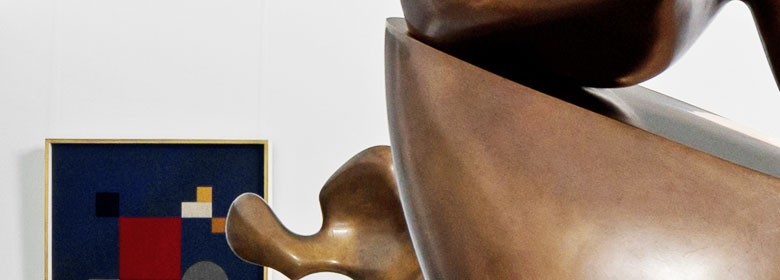
HISTORY
When Hans Arp died in 1966, he left behind an unusually rich and expansive artistic estate. It encompasses not only his artistic work, but also that of his first wife, the Swiss artist Sophie Taeuber. When Taeuber died following a tragic accident in 1943, she left Hans Arp the greater part of her significant oeuvre. At that time, the works were stored in the home studio in Clamart, near Paris, where Hans Arp and Sophie Taeuber-Arp lived and worked. Additional works were at Ronco dei Fiori, the property Arp and Marguerite Arp-Hagenbach acquired in Locarno, Switzerland. After Arp’s death, his second wife, Marguerite Arp-Hagenbach, was his sole heir. During their years together, the couple resided in Basel, Clamart and Tessin. As Hans Arp’s oeuvre gained widespread international recognition, they began searching for ways to preserve his artistic legacy for future generations. The Arps therefore bequeathed a large part of their collection of modern art to the city of Locarno in 1966. In 1968, two years after Arp’s death, his widow donated several renowned works from her own collection to the Kunstmuseum Basel, among them major works by Hans Arp and Sophie Taeuber-Arp.
In 1977 Marguerite Arp-Hagenbach began working with Johannes Wasmuth to found a non-profit foundation in Germany. The establishment of the non-profit helped facilitate a settlement between Marguerite Arp-Hagenbach and the French tax authorities, who had claimed outstanding taxes from the widow since the mid-1970s. Marguerite Arp-Hagenbach granted Johannes Wasmuth legal authority to found the Stiftung Hans Arp und Sophie Taeuber-Arp e. V.. The new nonprofit was based at the central train station in Rolandseck. In addition, she gave Wasmuth the task of transferring the rights to Hans Arp and Sophie Taeuber-Arp’s individual works and the couple’s collaborative works, as well as the casting rights to Hans Arp’s sculptures to the association. In addition, Wasmuth incorporated the artists’ Clamart library, furniture and additional household items into the holdings of the foundation. The Stiftung Arp e.V. later agreed that the furniture and household items would become the property of the French foundations. It was also agreed with the Swiss foundation that it would receive the copyright to Hans Arp’s artworks located in the Swiss canton of Ticino.
The founding meeting took place on September 7, 1977. In July 1978 the Stiftung Hans Arp und Sophie-Taueber-Arp e.V. was entered into the city of Bonn’s register of official non-profit associations. Marguerite Arp-Hagenbach and the direction of the Stiftung Arp e.V. then turned to the task of settling the outstanding taxes in France, which led to the foundation of the French Fondation Arp. Marguerite Arp-Hagenbach became the chair of the Fondation Arp’s executive board.
Over the course of the following years, the Stiftung Arp e.V. in Rolandseck worked to establish and carry out its mission. Its first great successes were the worldwide exhibitions and events marking the centennials of Hans Arp and Sophie Taeuber-Arp’s respective birthdays in 1986 and 1989.
During the mid-1990s, the Stiftung Arp e.V. and the state of Rhineland-Palatinate signed a framework agreement. Subsequently, the state established and financed the building of an Arp Museum in Rolandseck. The Stiftung Arp e.V. was to manage the museum, where its comprehensive collection would also be on display. Designed by the prominent American architect Richard Meier, the newly built museum opened in 2007. However, political pressure eventually led to the legal dissolution of the framework agreement and a legal settlement. From that time on, the state of Rhineland-Palatinate has been solely responsible for the management of the Arp Museum. The Stiftung Arp e.V. is once again an independent entity.
2010 marked a major turning point in the foundation’s history. Having rearticulated its mission, the Stiftung Arp e.V. opened its archive to independent research. Its aim in doing so is to support international scholarship on Hans Arp and Sophie Taeuber-Arp. Hans Arp. Skulpturen. Eine Bestandsaufnahme/A critical survey, edited by the respected art historian and museum director Arie Hartog, was published in 2012 and serves as the cornerstone of the foundation’s new approach.
The Stiftung Arp e.V. has not only repositioned itself conceptually, but also geographically. In December 2013, it also opened a Berlin branch in addition to its original seat in Rolandswerth. From now on, the foundation’s collection, archive and library will be made available to interested members of the public at the Berlin location. This additional space was needed in order to establish a strong connection to national and international scholarly and artistic discourses and to make the collection and archive more readily available to researchers.
Parts of the estates of Hans Arp and Sophie Taeuber-Arp are also cared for by the French Fondation Arp in Meudon and the Swiss Fondazione Marguerite Arp-Hagenbach in Locarno, which are located in the artist’s studio houses.
